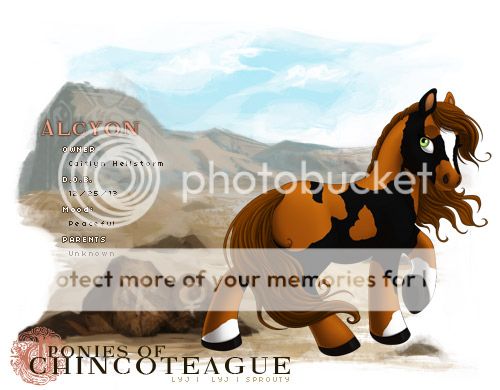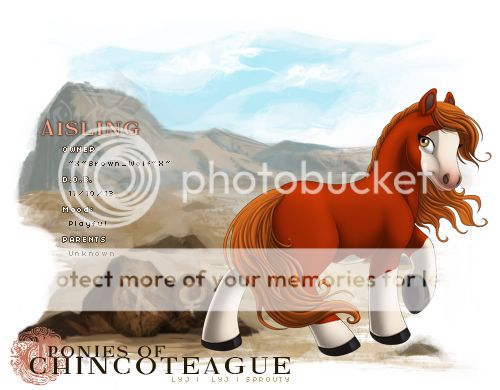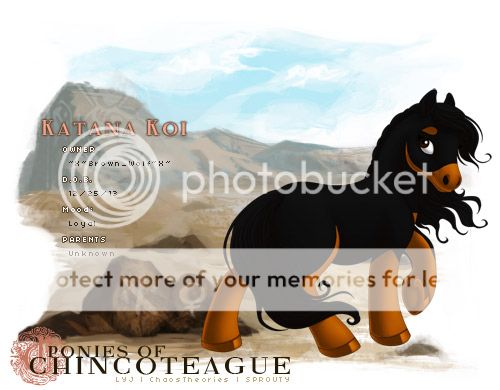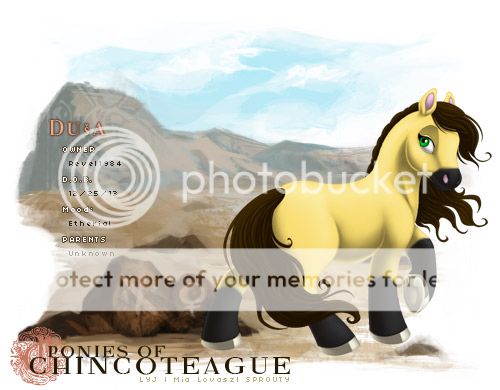Herd of the Dawn Treaders
Taken from the name of Prince Caspian's ship from the Chronicles of Narnia. We thought it semi-appropriate given the origins of the original ponies to the Isle. It has no in-character significance really, it's a name chosen to represent the herd by one of the late herd leaders.
► History:
It began as a fairly small, humble herd. Descendants of those first ponies that pulled themselves from the sea and took to the land. There were always myths of those days but as the time passed those myths became legends and those legends became mere foal-tales. The original herd split, and those herds split, and even those split, each adding their own twist to the tale and adapting to their new ways of life.
Their herd was no different. A lead stallion stood watch over his herd from the highest ground of their spring grazing lands and found that his herd was slowly growing too large. The resources were beginning to strain themselves, even in the spring and summer time. Winter would be difficult and perhaps even fatal for the ponies.
Calling his two eldest to him, the stallion decided it was time for another great divide. As Percival, his son, was the eldest, he would remain with the mother herd. Esper, along with her younger sister and half of the ponies, would cross the mountain pass to begin their lives in a land beyond the horizon. It was a difficult decision, and the divide meant saying farewell to friends and families alike, but for the good of the herd the two groups went their separate ways.
Word came shortly after the first frost dusted the grazing grounds, signaling for the herd to move on. The pass had recently become unstable and the ground itself broke, causing a landslide. No ponies were found, but the worst was assumed to have happened. Heartbroken, the herd's proud leader soon began neglecting himself and soon became unable to hold his position against challenging males. His son stepped up to take his place, allowing his father to retire with dignity and take up a peaceful position within the herd in which to live out the last of his days.
The elder stallion did not survive the autumn migration. Percival led his herd south through windswept plains and over rugged hills to their winter grazing grounds. With a heavy heart, the herd has begun their new life as a herd divided.
► Herd Structure & Traditions:
• Gender Roles:
Typical of natural horse structure, there is a very clear and distinct divide in roles between males and females. Males live on the border of the herd, putting themselves between their loved ones and the dangers that could be waiting for them on the outside. They are the soldiers, the guards, the proud and strong outriders that run to meet danger. It's their duty to keep the herd safe and obey their leader without hesitation. Females, on the other hand, are the caretakers. They make up the majority of the herd. They are the mothers, the healers, the quiet voices of reason, and the ones who often hold the most experience. Unlike males, females will spend much of their lives within the same herd. They know the terrain, they know what weather to expect, what grasses are best for nursing mothers or how to treat injured legs. Males will sometimes leave for the opportunity to start their own herd or be driven away if they challenge their current herd leader and meet with failure.
• Mating:
While it's typical for the lead stallion to have his pick out of the herd, in general the leaders have been kindly enough to allow the mares a chance to reject them if approached. It's not unheard of for the lead male to take several females for himself and guard them from the other males. The herd encourages monogamy but there have been times when the leader takes more than one mare for himself.
The outrider males are permitted to take multiple mares for themselves as well, bit it is a little outside of the norm. Common males typically are encouraged to take one mate but depending on the leader, they won't be punished if they fancy more than one lady. If they grow too ambitious and start claiming too many females or siring too many children, the lead stallion may ask them to leave or begin their own herd.
Stallions with mares only. This is how mating goes within the herd. Anything else is simply unheard of and would likely be driven away.
• Social Structure:
There really are only a few basic ranks. This may change as the herd grows, but currently this is how the herd's structure stands.
xx○ The Lead Stallion
The lead stallion is the strongest of the strong, the boldest of the bold, and has managed to defend his position against challengers. The lead stallion's life is often times the shortest within the herd as he is required to meet any threat personally before any others. He is required to accept challenges to his leadership and fight to hold his rank. If the lead stallion is defeated, the winner holds control of his fate. He may remain within the herd as an outrider or retire to live with the females. He may be driven away to find his fate elsewhere. In extreme cases- he could even be put to the hoof and laid low.
xx○ The Matriarch:
The matriarch is often times the oldest, most experienced mare within the herd. Sometimes, this role is taken up by a younger filly after her predecessor has passed away. This mare is the herd's diplomat, their navigator, and is often seen as the herd-mother. Even the lead stallion turns to her for guidance and wisdom. She will direct the herd during migrations, determine when it's best to move to a new grazing ground, and will often be the first to know when another mare is ready to give birth. Where the lead stallion protects the herd from without, the matriarch protect it from within.
xx○ The Outriders:
The outriders are the stallions of the herd. They will serve in this position from the time they are two years old to the time they either pass away, head out on their own, or overthrow the herd leader. The outriders are the guards and soldiers. They patrol the outskirts of the herd, keeping their eyes and ears open for danger and signs of trouble. If danger's shadow creeps over the herd, they alert the herd leader and join him in driving it away. Outriders are allowed to take females for themselves, but if they become over-ambitious and begin hoarding mates, the lead stallion is very likely to see this as an attempt to usurp him from the inside and may drive them, and possibly their mates, from the herd.
xx○ The Mares:
Mares make up the majority of the herd. The females live their lives under the safety net of their stallions, grazing and stretching their legs within the perimeter. Under most lead stallions, they have the right to deny a suitor or set their own terms. Under some, however, this right may be revoked. In general, they spend a lot of time together, sometimes keeping to their respective harems closer to where their stallion stands on patrol. They pair off when pregnant and often times a new mother will allow only one female to stay close to her and assist her while she recovers from the pregnancy.
xx○ The youths:
These are the youngsters of the herd. They are kept very close to their mothers and, depending on the stallion, may only associate with their fathers on occasion. When a colt has grown to his adulthood, his father will come to fetch him and introduce him to the border where he will serve.
xx○ The Elders:
Elders are ponies that have grown far too old or have been disabled in some way. They hold no duties to their rank but are revered for their wisdom. Cripples, however, are seen by some as something as a burden.
Views:
• Life-mating is preferred and often seen as more acceptable, but no one will question or frown down upon a stallion taking multiple mares for himself.
• Mating is between males and females only. Anything else is unheard of in this herd.
• Mating is between adults. Adults may not court minors.
• Males are free to leave to start their own herds, no one will stop them from doing so. It eliminates a threat to the lead stallion and it helps keep a maintainable herd.
• Females can leave, but it's encouraged that they leave with a stallion. It's rare for females to leave save for herd divisions.
• Youths are not allowed near the border, leaving is next to impossible. It's far too dangerous and it's very unlikely that they would get past the mares -and- the outriders.
• They tolerate small birds but anything predatory is driven off right away. Some outriders may even drive off other herbivores to eliminate competition for resources.
• They are not a hostile herd. They would not openly challenge another herd for territory or mares unless the situation becomes extremely dire. They will, however, boldly defend themselves if they brush shoulders with a hostile herd or rogue stallions.
• Rogues are welcome to join! Females are welcomed in without question but males will be on 'probation' for a short period of time and kept under watch by one of the outriders. When they've proven themselves trustworthy, they are free to stay.
• The lead stallion must take any and all challenges- be it from within or outside of the herd.







